Accounting Skills Assignment: Financial Analysis and Decision Making
VerifiedAdded on 2020/05/28
|9
|1532
|35
Homework Assignment
AI Summary
This accounting assignment delves into key financial concepts and their practical applications. The assignment begins by defining accounting, outlining its advantages and disadvantages, and then proceeds to calculate net income, owner's capital, and prepare a balance sheet. It then explores break-even analysis, determining break-even points in units and the total sales needed to achieve a target profit, and it calculates the impact of additional expenses on break-even points. The assignment also includes the preparation of a cash budget and schedules for expected collections and payments. Finally, it provides an explanation of the role of analytics in managerial decision-making, emphasizing its importance in evaluating business performance and making informed financial decisions. The assignment demonstrates an understanding of financial reporting, cost analysis, and budgeting techniques, supported by relevant references.
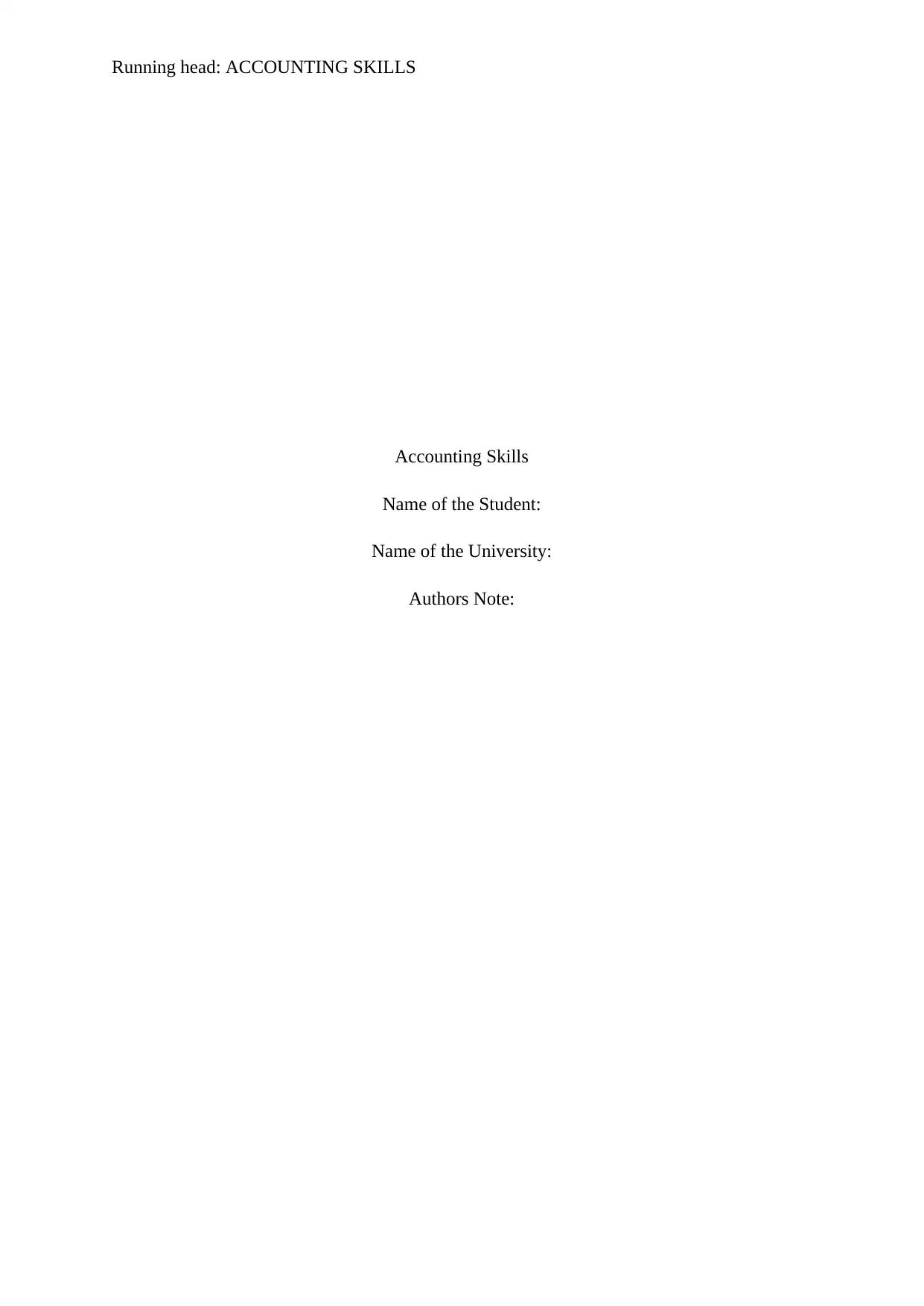
Running head: ACCOUNTING SKILLS
Accounting Skills
Name of the Student:
Name of the University:
Authors Note:
Accounting Skills
Name of the Student:
Name of the University:
Authors Note:
Paraphrase This Document
Need a fresh take? Get an instant paraphrase of this document with our AI Paraphraser
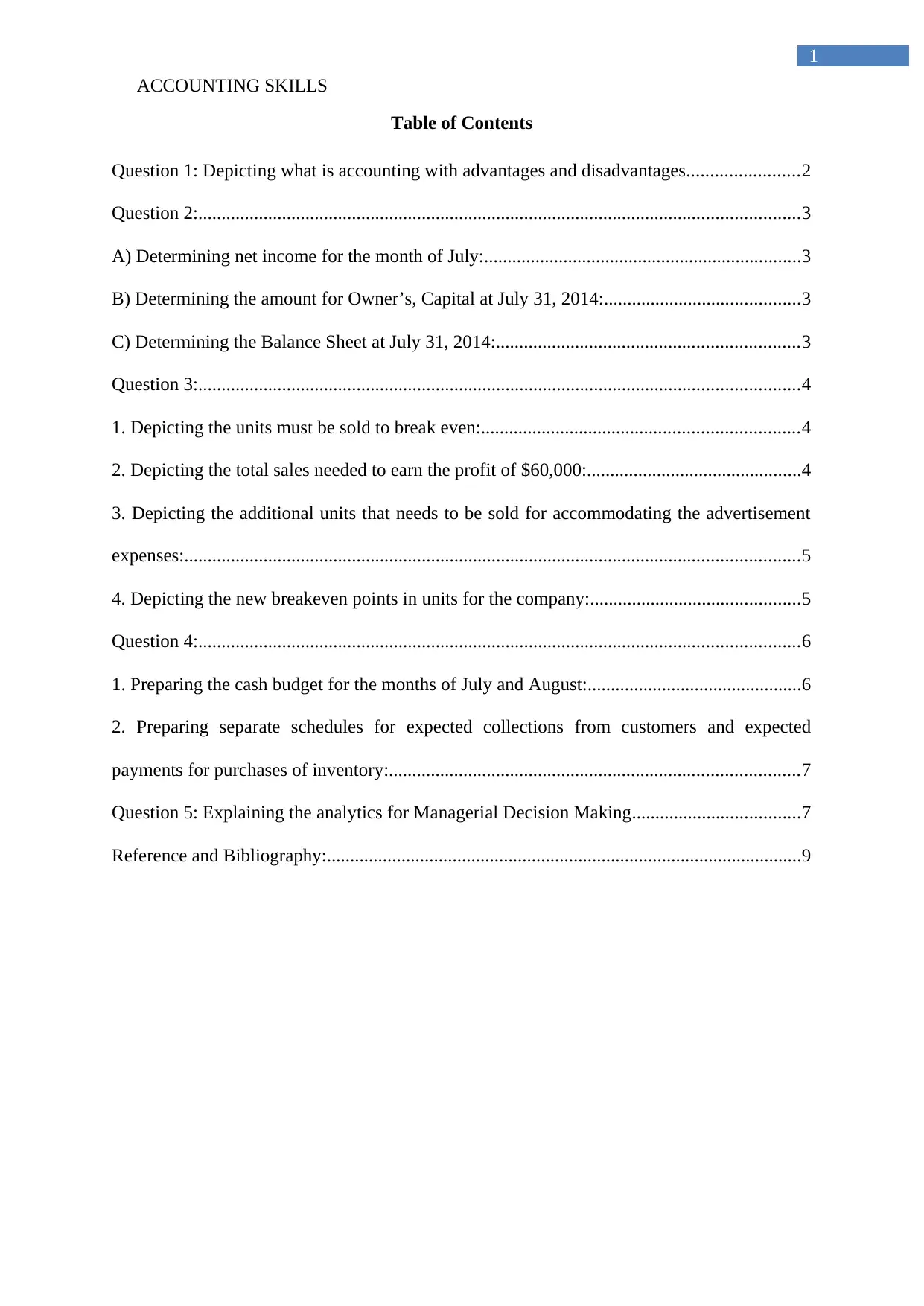
ACCOUNTING SKILLS
1
Table of Contents
Question 1: Depicting what is accounting with advantages and disadvantages........................2
Question 2:.................................................................................................................................3
A) Determining net income for the month of July:....................................................................3
B) Determining the amount for Owner’s, Capital at July 31, 2014:..........................................3
C) Determining the Balance Sheet at July 31, 2014:.................................................................3
Question 3:.................................................................................................................................4
1. Depicting the units must be sold to break even:....................................................................4
2. Depicting the total sales needed to earn the profit of $60,000:..............................................4
3. Depicting the additional units that needs to be sold for accommodating the advertisement
expenses:....................................................................................................................................5
4. Depicting the new breakeven points in units for the company:.............................................5
Question 4:.................................................................................................................................6
1. Preparing the cash budget for the months of July and August:..............................................6
2. Preparing separate schedules for expected collections from customers and expected
payments for purchases of inventory:........................................................................................7
Question 5: Explaining the analytics for Managerial Decision Making....................................7
Reference and Bibliography:......................................................................................................9
1
Table of Contents
Question 1: Depicting what is accounting with advantages and disadvantages........................2
Question 2:.................................................................................................................................3
A) Determining net income for the month of July:....................................................................3
B) Determining the amount for Owner’s, Capital at July 31, 2014:..........................................3
C) Determining the Balance Sheet at July 31, 2014:.................................................................3
Question 3:.................................................................................................................................4
1. Depicting the units must be sold to break even:....................................................................4
2. Depicting the total sales needed to earn the profit of $60,000:..............................................4
3. Depicting the additional units that needs to be sold for accommodating the advertisement
expenses:....................................................................................................................................5
4. Depicting the new breakeven points in units for the company:.............................................5
Question 4:.................................................................................................................................6
1. Preparing the cash budget for the months of July and August:..............................................6
2. Preparing separate schedules for expected collections from customers and expected
payments for purchases of inventory:........................................................................................7
Question 5: Explaining the analytics for Managerial Decision Making....................................7
Reference and Bibliography:......................................................................................................9
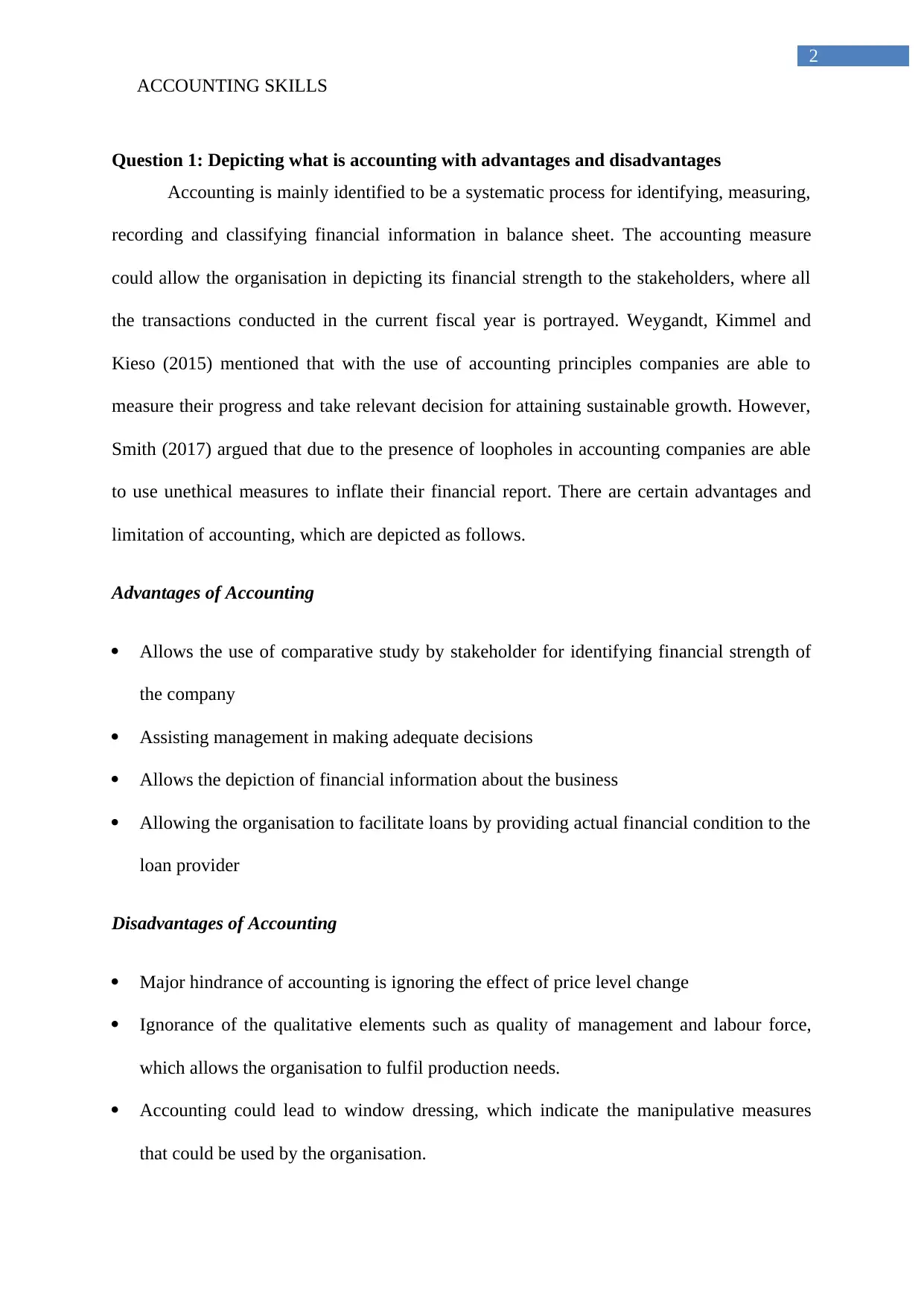
ACCOUNTING SKILLS
2
Question 1: Depicting what is accounting with advantages and disadvantages
Accounting is mainly identified to be a systematic process for identifying, measuring,
recording and classifying financial information in balance sheet. The accounting measure
could allow the organisation in depicting its financial strength to the stakeholders, where all
the transactions conducted in the current fiscal year is portrayed. Weygandt, Kimmel and
Kieso (2015) mentioned that with the use of accounting principles companies are able to
measure their progress and take relevant decision for attaining sustainable growth. However,
Smith (2017) argued that due to the presence of loopholes in accounting companies are able
to use unethical measures to inflate their financial report. There are certain advantages and
limitation of accounting, which are depicted as follows.
Advantages of Accounting
Allows the use of comparative study by stakeholder for identifying financial strength of
the company
Assisting management in making adequate decisions
Allows the depiction of financial information about the business
Allowing the organisation to facilitate loans by providing actual financial condition to the
loan provider
Disadvantages of Accounting
Major hindrance of accounting is ignoring the effect of price level change
Ignorance of the qualitative elements such as quality of management and labour force,
which allows the organisation to fulfil production needs.
Accounting could lead to window dressing, which indicate the manipulative measures
that could be used by the organisation.
2
Question 1: Depicting what is accounting with advantages and disadvantages
Accounting is mainly identified to be a systematic process for identifying, measuring,
recording and classifying financial information in balance sheet. The accounting measure
could allow the organisation in depicting its financial strength to the stakeholders, where all
the transactions conducted in the current fiscal year is portrayed. Weygandt, Kimmel and
Kieso (2015) mentioned that with the use of accounting principles companies are able to
measure their progress and take relevant decision for attaining sustainable growth. However,
Smith (2017) argued that due to the presence of loopholes in accounting companies are able
to use unethical measures to inflate their financial report. There are certain advantages and
limitation of accounting, which are depicted as follows.
Advantages of Accounting
Allows the use of comparative study by stakeholder for identifying financial strength of
the company
Assisting management in making adequate decisions
Allows the depiction of financial information about the business
Allowing the organisation to facilitate loans by providing actual financial condition to the
loan provider
Disadvantages of Accounting
Major hindrance of accounting is ignoring the effect of price level change
Ignorance of the qualitative elements such as quality of management and labour force,
which allows the organisation to fulfil production needs.
Accounting could lead to window dressing, which indicate the manipulative measures
that could be used by the organisation.
⊘ This is a preview!⊘
Do you want full access?
Subscribe today to unlock all pages.

Trusted by 1+ million students worldwide
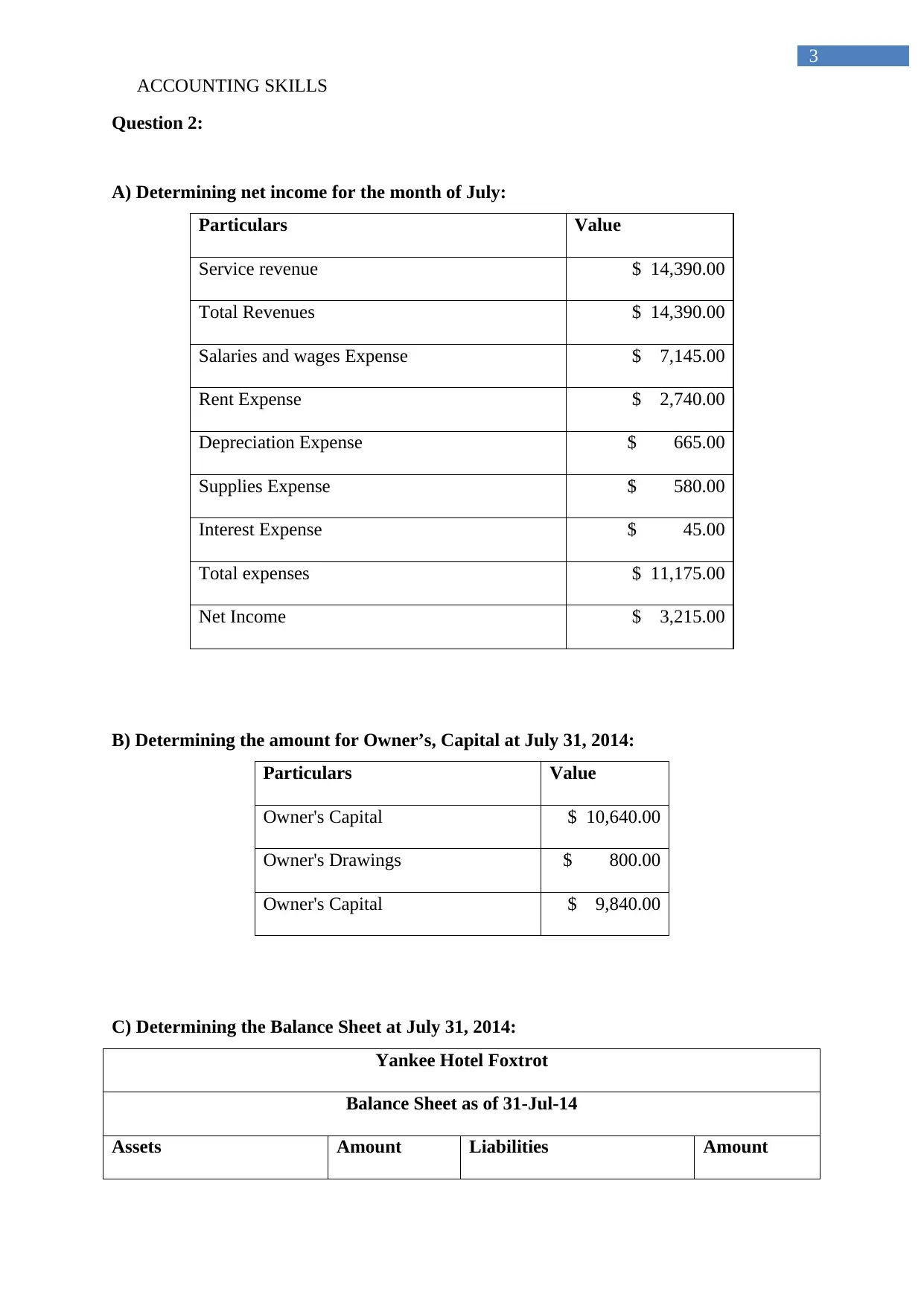
ACCOUNTING SKILLS
3
Question 2:
A) Determining net income for the month of July:
Particulars Value
Service revenue $ 14,390.00
Total Revenues $ 14,390.00
Salaries and wages Expense $ 7,145.00
Rent Expense $ 2,740.00
Depreciation Expense $ 665.00
Supplies Expense $ 580.00
Interest Expense $ 45.00
Total expenses $ 11,175.00
Net Income $ 3,215.00
B) Determining the amount for Owner’s, Capital at July 31, 2014:
Particulars Value
Owner's Capital $ 10,640.00
Owner's Drawings $ 800.00
Owner's Capital $ 9,840.00
C) Determining the Balance Sheet at July 31, 2014:
Yankee Hotel Foxtrot
Balance Sheet as of 31-Jul-14
Assets Amount Liabilities Amount
3
Question 2:
A) Determining net income for the month of July:
Particulars Value
Service revenue $ 14,390.00
Total Revenues $ 14,390.00
Salaries and wages Expense $ 7,145.00
Rent Expense $ 2,740.00
Depreciation Expense $ 665.00
Supplies Expense $ 580.00
Interest Expense $ 45.00
Total expenses $ 11,175.00
Net Income $ 3,215.00
B) Determining the amount for Owner’s, Capital at July 31, 2014:
Particulars Value
Owner's Capital $ 10,640.00
Owner's Drawings $ 800.00
Owner's Capital $ 9,840.00
C) Determining the Balance Sheet at July 31, 2014:
Yankee Hotel Foxtrot
Balance Sheet as of 31-Jul-14
Assets Amount Liabilities Amount
Paraphrase This Document
Need a fresh take? Get an instant paraphrase of this document with our AI Paraphraser
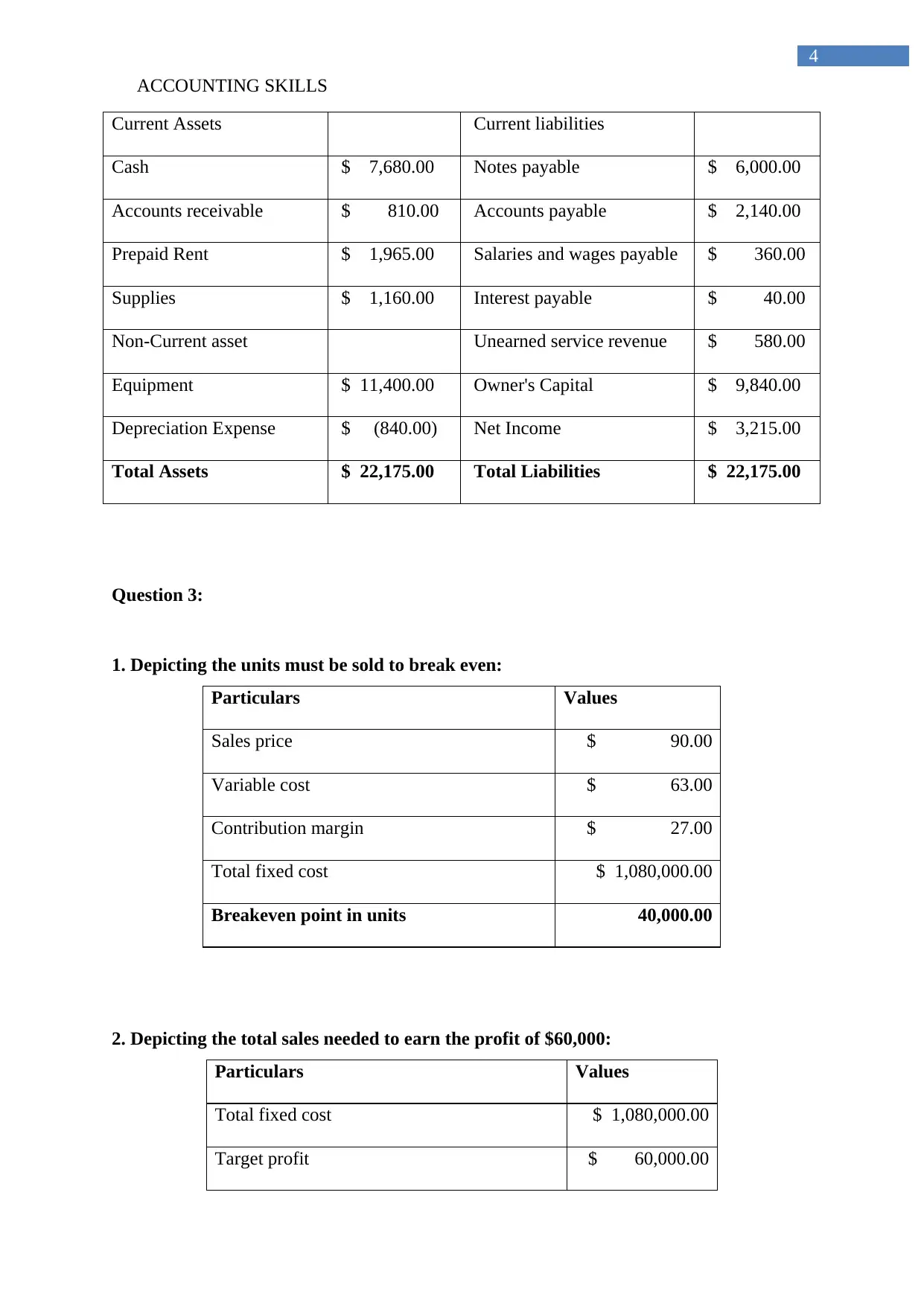
ACCOUNTING SKILLS
4
Current Assets Current liabilities
Cash $ 7,680.00 Notes payable $ 6,000.00
Accounts receivable $ 810.00 Accounts payable $ 2,140.00
Prepaid Rent $ 1,965.00 Salaries and wages payable $ 360.00
Supplies $ 1,160.00 Interest payable $ 40.00
Non-Current asset Unearned service revenue $ 580.00
Equipment $ 11,400.00 Owner's Capital $ 9,840.00
Depreciation Expense $ (840.00) Net Income $ 3,215.00
Total Assets $ 22,175.00 Total Liabilities $ 22,175.00
Question 3:
1. Depicting the units must be sold to break even:
Particulars Values
Sales price $ 90.00
Variable cost $ 63.00
Contribution margin $ 27.00
Total fixed cost $ 1,080,000.00
Breakeven point in units 40,000.00
2. Depicting the total sales needed to earn the profit of $60,000:
Particulars Values
Total fixed cost $ 1,080,000.00
Target profit $ 60,000.00
4
Current Assets Current liabilities
Cash $ 7,680.00 Notes payable $ 6,000.00
Accounts receivable $ 810.00 Accounts payable $ 2,140.00
Prepaid Rent $ 1,965.00 Salaries and wages payable $ 360.00
Supplies $ 1,160.00 Interest payable $ 40.00
Non-Current asset Unearned service revenue $ 580.00
Equipment $ 11,400.00 Owner's Capital $ 9,840.00
Depreciation Expense $ (840.00) Net Income $ 3,215.00
Total Assets $ 22,175.00 Total Liabilities $ 22,175.00
Question 3:
1. Depicting the units must be sold to break even:
Particulars Values
Sales price $ 90.00
Variable cost $ 63.00
Contribution margin $ 27.00
Total fixed cost $ 1,080,000.00
Breakeven point in units 40,000.00
2. Depicting the total sales needed to earn the profit of $60,000:
Particulars Values
Total fixed cost $ 1,080,000.00
Target profit $ 60,000.00
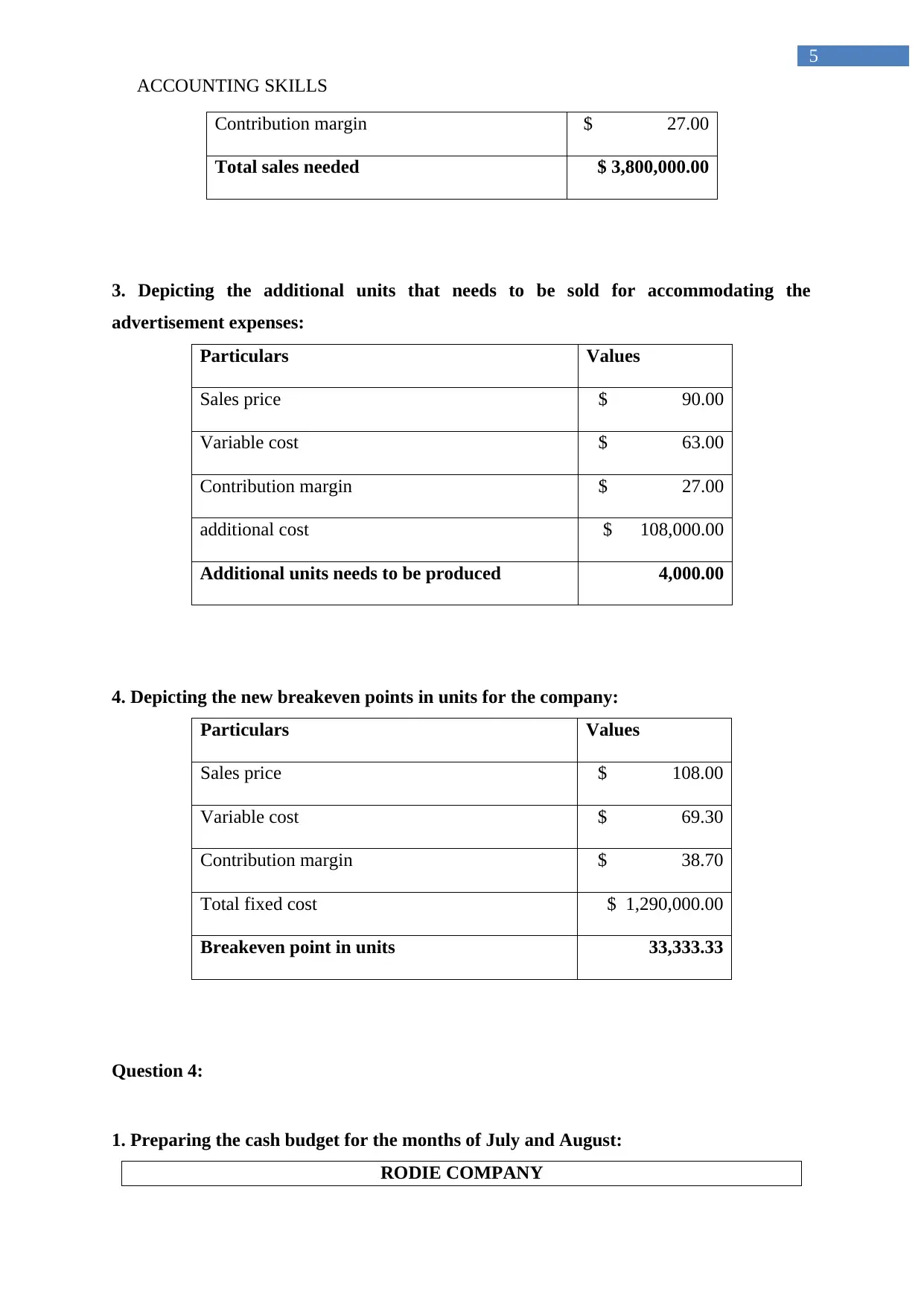
ACCOUNTING SKILLS
5
Contribution margin $ 27.00
Total sales needed $ 3,800,000.00
3. Depicting the additional units that needs to be sold for accommodating the
advertisement expenses:
Particulars Values
Sales price $ 90.00
Variable cost $ 63.00
Contribution margin $ 27.00
additional cost $ 108,000.00
Additional units needs to be produced 4,000.00
4. Depicting the new breakeven points in units for the company:
Particulars Values
Sales price $ 108.00
Variable cost $ 69.30
Contribution margin $ 38.70
Total fixed cost $ 1,290,000.00
Breakeven point in units 33,333.33
Question 4:
1. Preparing the cash budget for the months of July and August:
RODIE COMPANY
5
Contribution margin $ 27.00
Total sales needed $ 3,800,000.00
3. Depicting the additional units that needs to be sold for accommodating the
advertisement expenses:
Particulars Values
Sales price $ 90.00
Variable cost $ 63.00
Contribution margin $ 27.00
additional cost $ 108,000.00
Additional units needs to be produced 4,000.00
4. Depicting the new breakeven points in units for the company:
Particulars Values
Sales price $ 108.00
Variable cost $ 69.30
Contribution margin $ 38.70
Total fixed cost $ 1,290,000.00
Breakeven point in units 33,333.33
Question 4:
1. Preparing the cash budget for the months of July and August:
RODIE COMPANY
⊘ This is a preview!⊘
Do you want full access?
Subscribe today to unlock all pages.

Trusted by 1+ million students worldwide
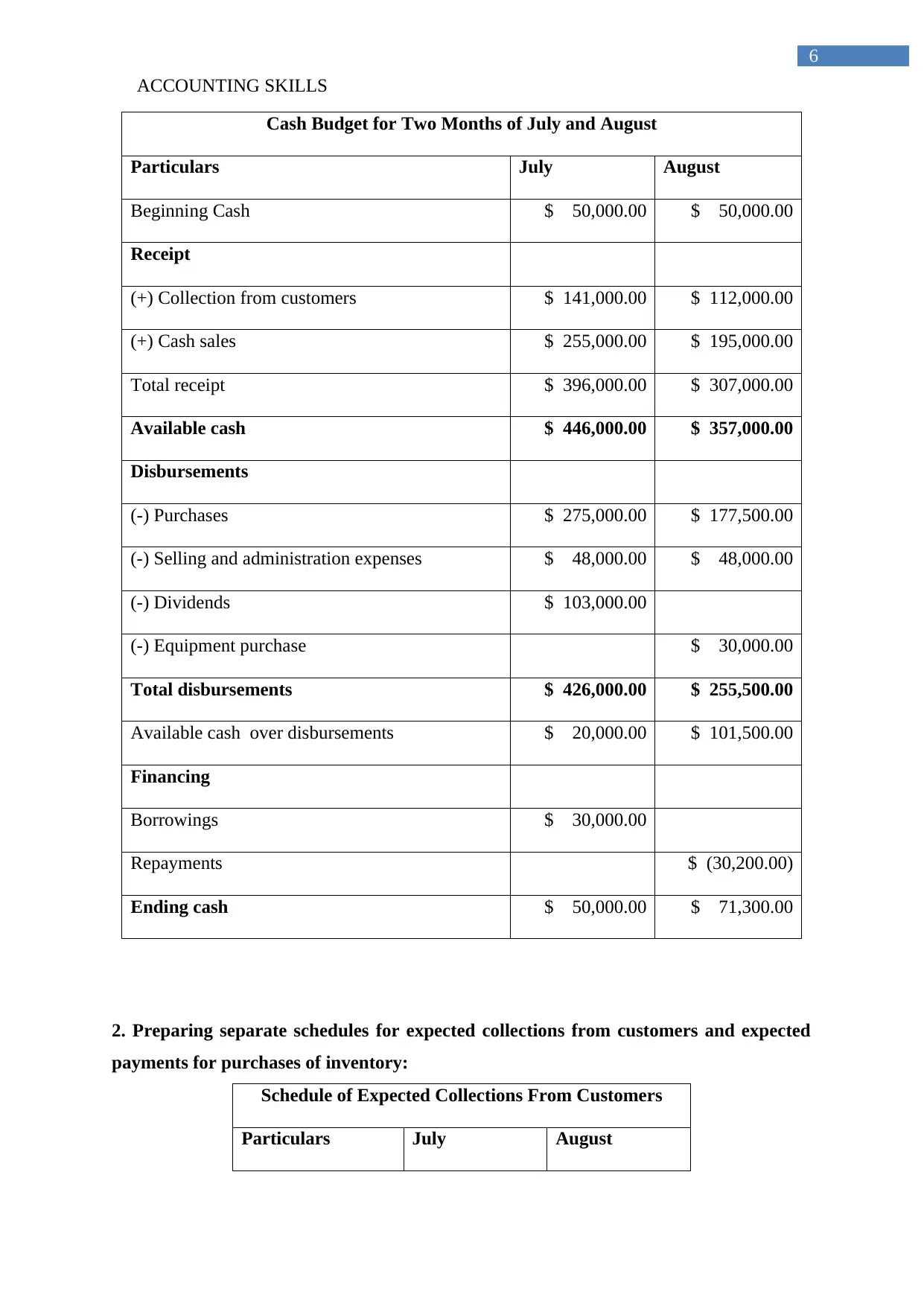
ACCOUNTING SKILLS
6
Cash Budget for Two Months of July and August
Particulars July August
Beginning Cash $ 50,000.00 $ 50,000.00
Receipt
(+) Collection from customers $ 141,000.00 $ 112,000.00
(+) Cash sales $ 255,000.00 $ 195,000.00
Total receipt $ 396,000.00 $ 307,000.00
Available cash $ 446,000.00 $ 357,000.00
Disbursements
(-) Purchases $ 275,000.00 $ 177,500.00
(-) Selling and administration expenses $ 48,000.00 $ 48,000.00
(-) Dividends $ 103,000.00
(-) Equipment purchase $ 30,000.00
Total disbursements $ 426,000.00 $ 255,500.00
Available cash over disbursements $ 20,000.00 $ 101,500.00
Financing
Borrowings $ 30,000.00
Repayments $ (30,200.00)
Ending cash $ 50,000.00 $ 71,300.00
2. Preparing separate schedules for expected collections from customers and expected
payments for purchases of inventory:
Schedule of Expected Collections From Customers
Particulars July August
6
Cash Budget for Two Months of July and August
Particulars July August
Beginning Cash $ 50,000.00 $ 50,000.00
Receipt
(+) Collection from customers $ 141,000.00 $ 112,000.00
(+) Cash sales $ 255,000.00 $ 195,000.00
Total receipt $ 396,000.00 $ 307,000.00
Available cash $ 446,000.00 $ 357,000.00
Disbursements
(-) Purchases $ 275,000.00 $ 177,500.00
(-) Selling and administration expenses $ 48,000.00 $ 48,000.00
(-) Dividends $ 103,000.00
(-) Equipment purchase $ 30,000.00
Total disbursements $ 426,000.00 $ 255,500.00
Available cash over disbursements $ 20,000.00 $ 101,500.00
Financing
Borrowings $ 30,000.00
Repayments $ (30,200.00)
Ending cash $ 50,000.00 $ 71,300.00
2. Preparing separate schedules for expected collections from customers and expected
payments for purchases of inventory:
Schedule of Expected Collections From Customers
Particulars July August
Paraphrase This Document
Need a fresh take? Get an instant paraphrase of this document with our AI Paraphraser
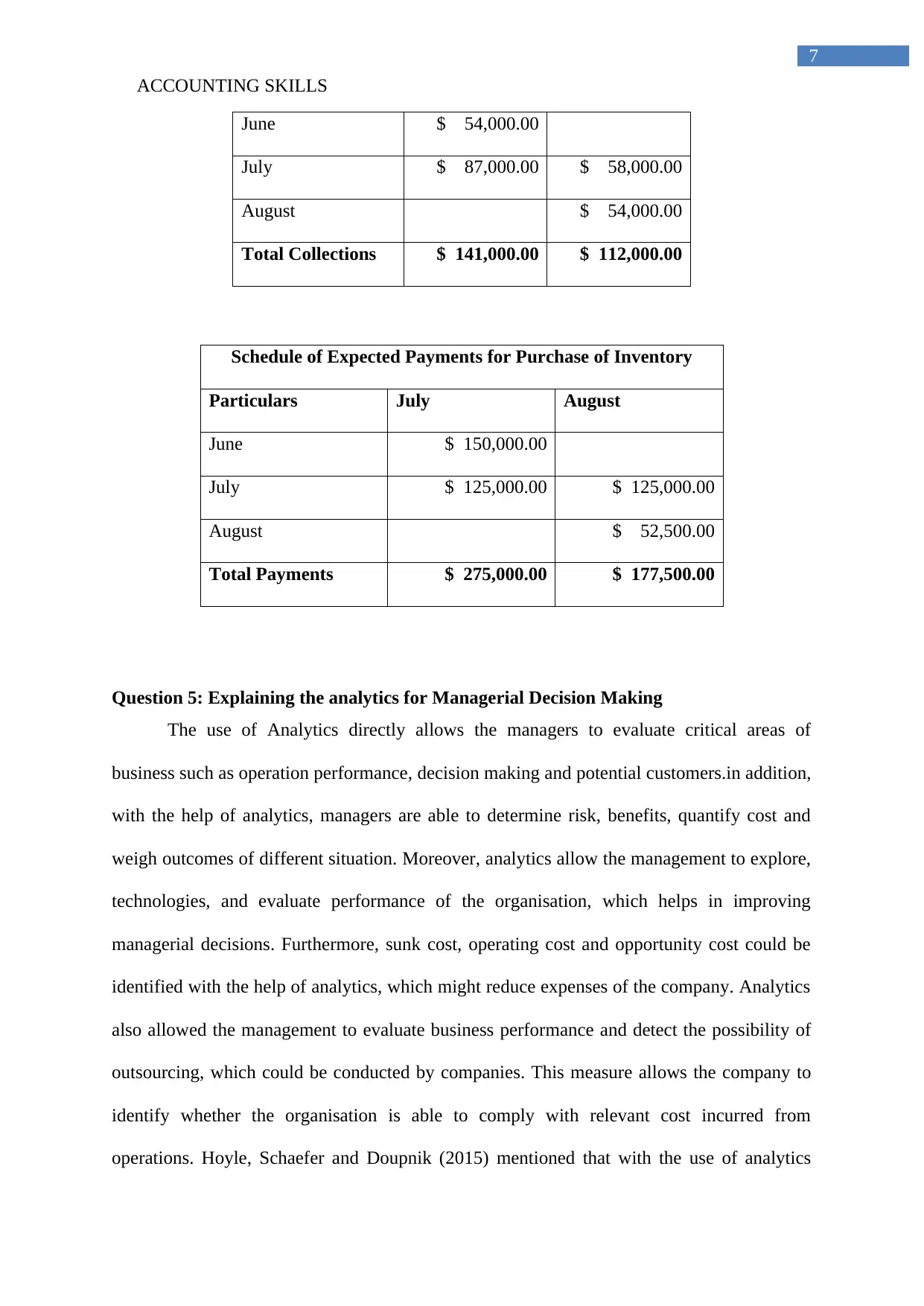
ACCOUNTING SKILLS
7
June $ 54,000.00
July $ 87,000.00 $ 58,000.00
August $ 54,000.00
Total Collections $ 141,000.00 $ 112,000.00
Schedule of Expected Payments for Purchase of Inventory
Particulars July August
June $ 150,000.00
July $ 125,000.00 $ 125,000.00
August $ 52,500.00
Total Payments $ 275,000.00 $ 177,500.00
Question 5: Explaining the analytics for Managerial Decision Making
The use of Analytics directly allows the managers to evaluate critical areas of
business such as operation performance, decision making and potential customers.in addition,
with the help of analytics, managers are able to determine risk, benefits, quantify cost and
weigh outcomes of different situation. Moreover, analytics allow the management to explore,
technologies, and evaluate performance of the organisation, which helps in improving
managerial decisions. Furthermore, sunk cost, operating cost and opportunity cost could be
identified with the help of analytics, which might reduce expenses of the company. Analytics
also allowed the management to evaluate business performance and detect the possibility of
outsourcing, which could be conducted by companies. This measure allows the company to
identify whether the organisation is able to comply with relevant cost incurred from
operations. Hoyle, Schaefer and Doupnik (2015) mentioned that with the use of analytics
7
June $ 54,000.00
July $ 87,000.00 $ 58,000.00
August $ 54,000.00
Total Collections $ 141,000.00 $ 112,000.00
Schedule of Expected Payments for Purchase of Inventory
Particulars July August
June $ 150,000.00
July $ 125,000.00 $ 125,000.00
August $ 52,500.00
Total Payments $ 275,000.00 $ 177,500.00
Question 5: Explaining the analytics for Managerial Decision Making
The use of Analytics directly allows the managers to evaluate critical areas of
business such as operation performance, decision making and potential customers.in addition,
with the help of analytics, managers are able to determine risk, benefits, quantify cost and
weigh outcomes of different situation. Moreover, analytics allow the management to explore,
technologies, and evaluate performance of the organisation, which helps in improving
managerial decisions. Furthermore, sunk cost, operating cost and opportunity cost could be
identified with the help of analytics, which might reduce expenses of the company. Analytics
also allowed the management to evaluate business performance and detect the possibility of
outsourcing, which could be conducted by companies. This measure allows the company to
identify whether the organisation is able to comply with relevant cost incurred from
operations. Hoyle, Schaefer and Doupnik (2015) mentioned that with the use of analytics
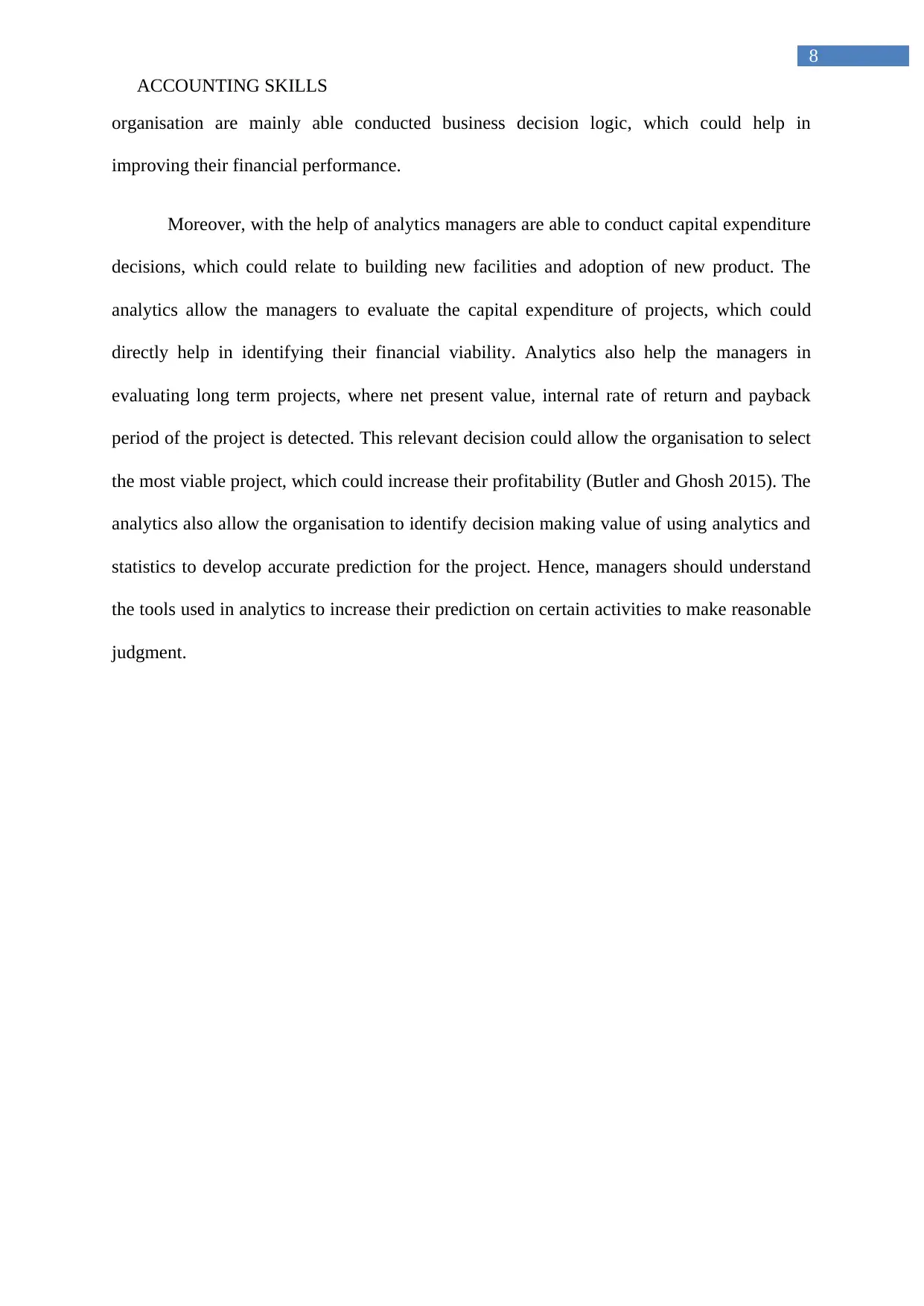
ACCOUNTING SKILLS
8
organisation are mainly able conducted business decision logic, which could help in
improving their financial performance.
Moreover, with the help of analytics managers are able to conduct capital expenditure
decisions, which could relate to building new facilities and adoption of new product. The
analytics allow the managers to evaluate the capital expenditure of projects, which could
directly help in identifying their financial viability. Analytics also help the managers in
evaluating long term projects, where net present value, internal rate of return and payback
period of the project is detected. This relevant decision could allow the organisation to select
the most viable project, which could increase their profitability (Butler and Ghosh 2015). The
analytics also allow the organisation to identify decision making value of using analytics and
statistics to develop accurate prediction for the project. Hence, managers should understand
the tools used in analytics to increase their prediction on certain activities to make reasonable
judgment.
8
organisation are mainly able conducted business decision logic, which could help in
improving their financial performance.
Moreover, with the help of analytics managers are able to conduct capital expenditure
decisions, which could relate to building new facilities and adoption of new product. The
analytics allow the managers to evaluate the capital expenditure of projects, which could
directly help in identifying their financial viability. Analytics also help the managers in
evaluating long term projects, where net present value, internal rate of return and payback
period of the project is detected. This relevant decision could allow the organisation to select
the most viable project, which could increase their profitability (Butler and Ghosh 2015). The
analytics also allow the organisation to identify decision making value of using analytics and
statistics to develop accurate prediction for the project. Hence, managers should understand
the tools used in analytics to increase their prediction on certain activities to make reasonable
judgment.
⊘ This is a preview!⊘
Do you want full access?
Subscribe today to unlock all pages.

Trusted by 1+ million students worldwide
1 out of 9
Related Documents
Your All-in-One AI-Powered Toolkit for Academic Success.
+13062052269
info@desklib.com
Available 24*7 on WhatsApp / Email
![[object Object]](/_next/static/media/star-bottom.7253800d.svg)
Unlock your academic potential
Copyright © 2020–2025 A2Z Services. All Rights Reserved. Developed and managed by ZUCOL.





